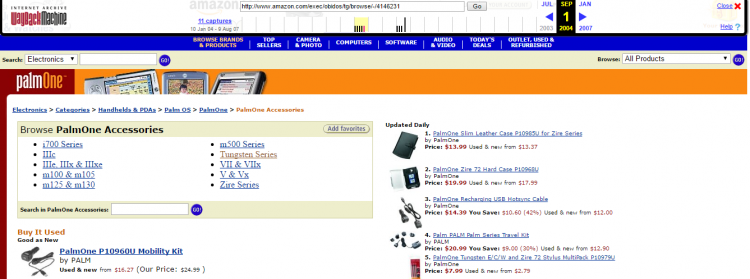News broke this week that Incipio is acquiring Griffin, hot on the heels of Incipio also acquiring Skullcandy, Otterbox acquiring Lifeproof, Mophie being acquired by Zagg, and going back a few years, Sena being acquired by Targus and Speck by Samsonite.
It’s crazy how fast these companies have been merging and consolidating, but I think it reflects two huge sea changes in the accessories markets-online shopping and the rise of the smartphone.
(Note: Just iPhone 6/6S cases alone totaled over 2 million on Amazon!)
Online shopping has been both friend and foe to many of these case companies. Most of them were started during the rise of Palm, Pocket PC, and the iPod, and they relied heavily on word of mouth and online reviews for business. I know I didn’t know who Sena was until I started reading gadget blogs! At the same time, once I saw reviews, I immediately ordered a leather case for my beloved Palm TX. This was back in 2006, when Amazon wasn’t on my radar as much other than a place to get books, and maybe a few other random items.
In fact, thanks to the magic of the Wayback Machine, I was able to go back and browse for Palm accessories on Amazon in 2004. There wasn’t much there … a three pack of Speck cases for $26, a PalmOne leather case for the Zire series for $13.99, and a few styluses and screen protectors. Remember that in 2004 Palm was still a relatively big deal; the iPhone wasn’t announced until January 2007, and the only smartphones out there were Palm, Pocket PC, and Blackberry, and smartphones and data plans were insanely expensive for the average person. In fact, even in January 2007, the Wayback Machine showed very few Palm accessories, and most of them appeared to be in the $15+ range for cases and $30ish for cables. Basically, there was no “oh, cool case, let me see if it’s cheaper on Amazon”, consumers HAD to buy direct from the case companies.
Fast forward to today, and Amazon has cases for nearly everything. Want a high-end leather case? Amazon has it. Want to spend $5 and get a simple TPU case? Amazon has that too. Don’t want to spring for an Otterbox? Ever heard of SUPCase? They make solid, rugged cases for a variety of devices, and you can find a case of theirs to fit your phone for under $20, often under $15 if you shop carefully. The rise of the smartphone coincided with the rise of Amazon as a marketplace for everything, not just books and a few random other things, and that’s given a marketplace to a tremendous number of knock-off/copycat/cheaper versions of cases. If you wanted a rugged case for your original iPhone, you were buying an Otterbox. Today, if you don’t want to spend that much on an iPhone case, there are literally hundreds of choices at just about every price point you could imagine. They may not be as high quality, but if you’re ok with lesser quality for lesser cost, Amazon and eBay can easily connect you to an affordable option.
This simply didn’t exist when companies like Griffin were founded, and that changed the game a lot for them. The other piece of this puzzle is, in my opinion, the rise of the smartphone over iPods and PDAs. If you bought a PDA from a Staples or a Best Buy, they carried a handful of cases (likely at full price), or you could jump online and go directly to the case manufacturers for more choices. If you bought an iPod, you probably saw Griffin, Speck, and a few other big names at the Apple Store or Best Buy or wherever you bought your iPod. Then smartphones came along, and with them came sales at carrier stores.
It might seem like a lateral change, from Best Buy and Staples to AT&T and Verizon stores, but the difference is that carrier stores have a more captive audience that can be more easily upsold than in a big box retailer. If you try to buy a smartphone in a carrier store today, chances are excellent they will do everything in their power to make sure you walk out with a case, a car charger, a Bluetooth headset, or some other combination bundle. Oftentimes there’s a “sale” or discount if you buy the accessories alongside your phone, making it an even more enticing deal. But here’s the rub: only a handful of case companies are being featured. I’ve personally noticed Speck, Case-Mate, Incipio, and Otterbox at my local Verizon store and that’s it. AT&T seems especially fond of Speck’s Candyshell line, as just about everyone I know who buys their phones from AT&T seems to end up with one of those cases. Again, this puts the squeeze on companies who aren’t as well represented or have connections within the carrier stores.
So in my view, there were two major market forces that have led to the current run of consolidation. On the one hand, consumers are being offered more choices for less money thanks to Amazon, and eBay exposing consumers to mass market and knockoff cases. On the other hand, when consumers ARE willing to pay full price, they’re often in a situation where their choices are limited, making it that much harder if you aren’t part of the carrier’s chosen brands. It’s simply not possible for all these case makers to share increasingly tiny slices of the pie, so it makes sense that they’re slowly merging together because otherwise they’ll simply be squeezed out entirely.
What’s your take on market consolidation? Do you think accessory makers are facing new headwinds, or is there something else at work with all these mergers? Leave your thoughts below!



